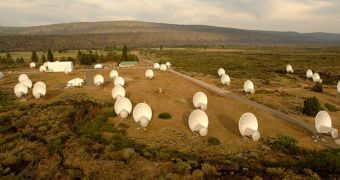Due to lack of funding, the Allen Telescope Array (ATA) has been put into what experts at the Search for Extraterrestrial Intelligence (SETI) are calling a safe mode. This means that the equipment at the northern California site will be kept minimally operational, by a heavily reduced staff.
This measure ensures that, once additional sources of funding become available, the telescope could be turned back one, and resume its observations of the night sky. The announcement was made last week by SETI Institute CEO, Tom Pierson.
He explains that the site is now in a state where “the equipment is unavailable for normal observations and is being maintained in a safe state by a significantly reduced staff.” This has been going on since April 15, Universe Today reports.
Even though SETI searches have very specific profiles, the ATA is not the only observatory that can be used to conduct searches for signals originating from extraterrestrial civilizations. But it was one of the few facilities in the world dedicated precisely to this objective.
According to analysts, the Institute will now be forced to start borrowing time on other, similar arrays, which will be very expensive. Another option to get out of this predicament would be to use data from other ongoing studies to monitor the skies.
However, none of these methods come even close to the full capabilities of a fully-functional ATA, experts say. The array now has 42, six-meter antennas for radio astronomy, but the end goal is to increase this number to no less than 350.
Since the first phase of the ATA construction project was concluded, back in 2007, no new funds were put into the project. The first phase required $50 million to complete, and half of that sum was put forth by Microsoft co-founder Paul Allen.
“Because the project is mainly funded through private donors, the economic recession had a huge impact and delayed significantly the expansion of the array impacting the overall project,” explains SETI Institute astronomer Franck Marchis on his blog.
He is also based at the University of California in Berkeley (UCB). The institution is responsible for operating the ATA, but a lack of funding here has forced the project to a standstill.
“The financial state of the observatory degraded significantly over the past 2 years with the loss of various sources of funding” at UCB, explains the expert. For example, the US National Science Foundation (NSF) is now only providing one tenth of the sum it used to give.
ATA operations and SETI investigations cost about $2.5 million annually, documents show. The Institute is now appealing to the general public to provide it with the funds necessary to look for alien civilizations.

 14 DAY TRIAL //
14 DAY TRIAL //